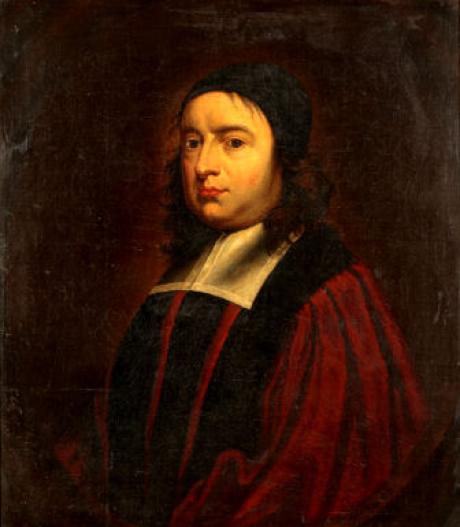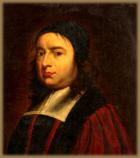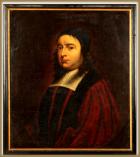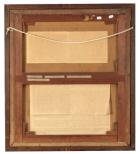At the outbreak of the Civil War John Hewett attached himself to the Royalist cause; by 1643 he was chaplain to King Charles I at Oxford, and had impressed the King to such an extent that the received the degree of Doctor of Divinity by Royal Mandate on 17th October of that year. This portrait depicts him in the distinctive scarlet robes of that degree.
John Hewitt [Hewytt, Hewett], (bap. 1614, d. 1658), Church of England clergyman and royalist conspirator, was baptized at Eccles, Lancashire, on 4 September 1614, the fourth son of Thomas Hewett, clothworker, of Eccles. Educated at Bolton-le-Moors School and Pembroke College, Cambridge (where he matriculated sizar on 13 May 1633), Hewitt took no degree, and his whereabouts are largely unclear during the following years. He may have been living in London, where he married, on 18 December 1636, Elizabeth Skinner (d. in or before 1649), daughter of Robert Skinner, a merchant taylor of St Botolph, Aldgate. Hewitt is next recorded during the civil wars, at Oxford, where he was created DD on 17 October 1643 and by 1649 was serving as chaplain to his brother-in-law, Montague Bertie, second earl of Lindsey; Hewitt had recently married Lady Mary Bertie (1618–1669), daughter of Robert, first earl of Lindsey (d. 1642), and his wife, Elizabeth Montague (d. 1655). It was perhaps at this time that Hewitt became minister of St Gregory by Paul, London, and rector of St Mary Magdalen, Old Fish Street. A popular and influential preacher, his sermons were attended by many leading royalists, and Oliver Cromwell allegedly told him that he 'was like a flaming Torch in the midst of a sheaf of Corn: he meaning, I being a publick Preacher, was able to set the Citie on fire by sedition and cumbustions, and promoting designs' (Speech and Prayer, 4).
Hewit had become an inspiring example of the Royalist martyr. The briefest look at his career shows that the truth was far from being so straightforward. It is testimony both to Hewit's abilities and to a surprising tolerance in the Cromwellian regime that where other Royalist clergy retired into obscurity at the end of the Civil War, this former Royal chaplain not only held a living in London but acted as a celebrant at the wedding of Cromwell's daughter in 1657. That he could do this without considering it any compromise of his devotedly loyal sympathies is an intriguing paradox that suggests a certain complexity of character. This is born out by his remarkable rise from obscurity to a position of closeness to the prinicipal figures on either side of the conflict. That this career should end on the block is a less predictable conclusion than might first seem, and Hewit was condemned more by the company he kept than by any definite act.
This startling promotion shows that he had some considerable persuasive gift. He was also considered to have a particular talent for proselytising in the Royal interest and he was sent to win converts in his home territory of Cheshire and Lancashire. Local and Royalist sympathies must have brought him into the orbit of the Bertie family, Earls of Lindsey. He was engaged as chaplain to the devotedly loyal Montague Bertie, 2nd Earl of Lindsey, whose father had died of wounds at the Battle of Edgehill in 1642. The second Lord Lindsey and Hewit were well-matched in their loyalty to the Stuarts: the Earl was one of the seven peers who offered themselves to Parliament in 1649 as proxy victims for the King. Most remarkably, however, during this period Hewit, a widower, married the Earl''s sister, Lady Mary Bertie as his second wife. For a clergyman of no background to marry the daughter of an Earl, even in the straightened times of the Civil War, remains an extraordinary circumstance, and like so many of the appointments of his life, testifies to some considerable character on Hewit's part - and, as other achievements, some great reserves of charm.
After the Civil War he was chosen as a minister of St Gregory's by St Paul's. This is remarkable, once again, not only for his previous support for the Crown, but for the fact that he continued in this appointment to use prescribed forms of service and even -after the execution of King Charles I- to take up collections for Charles II, urging the congregation to ''remember a distressed friend''. Extraordinarily this explicit refusal to follow the established form of worship in Cromwellian England did not at all deprive him of his living or of acquiring a position to the family of the Protector which seems very similar to that he exercised for the King at Oxford.
In November 1657 Cromwell's daughter Mary married Thomas Belasyse, Lord Fauconberg. Though he was later to support the Restoration, Lord Fauconberg was a trusted partisan of Cromwell, and was summoned to his reformed House of Lords in the following month. John Hewit officiated at this wedding, which was doubly celebrated, both at Hampton Court, the Protector's favourite residence, and at Whitehall. Why, one wonders, was Hewit chosen out of a mass of orthodox puritan clergy? It is impossible to know. Perhaps -as later events also suggest- he had some personal friendship with Cromwell's daughters. Perhaps it was even covertly recognised that he was a person who from his previous employment might impart a proper decorum -and legitimacy?- to the occasion.
Hewitt's prayer-book Anglicanism was tolerated by the Cromwellian regime, but during the mid-1650s his congregation became the centre for less acceptable royalist endeavours. Hewitt was reputedly responsible for collecting hundreds of pounds for the king, and his house became a meeting place for royalists and the focal point for conspiracy. In late 1657 he became involved in a plot in which were implicated or rumoured to be implicated old royalists and presbyterians, including John Stapley of Sussex, Sir William Waller, and Sir Thomas Fairfax, who were to raise a force in support of a Spanish invasion. This plot was arguably based on wishful thinking rather than genuine potential, and senior royalists such as Ormond concluded that it was 'managed by honest but unskillful men' (Carte, 2.118). Another contemporary claimed that Hewitt was 'rather a Tully than a Cataline, and hath been more prevalent with his tongue than his brain' (Underdown, 1.718). Furthermore, the Cromwellian regime knew of the plot from an early stage, thanks to a double agent, and kept Hewitt under close surveillance until ready to make their move. When Stapley was questioned in the spring of 1658 he made a full confession, and Hewitt was arrested on 8 April and sent to the Tower. The government's powerful intelligence system ensured that, while some expected Hewitt to be acquitted, the secretary of state John Thurloe felt confident that the evidence was damning. It soon became clear that the high court of justice would make an example of the plotters, and the ground was laid by an officially inspired tract, The Horrible and Bloody Conspiracy.
Hewitt was tried on 1 June 1658, charged with 'minding and intending to embroil this commonwealth in new and intestine wars'. The prosecution said that he 'did traiterously, advisedly and maliciously plot, contrive and endeavour to stir up, force and levy war' (State trials, 5.884). Although without counsel Hewitt was tutored by the leading presbyterian royalist, William Prynne, who later published an account of the trial as Beheaded Dr John Hewytts Ghost. Under his tuition Hewitt refused to recognize the authority of the court, and he refused to enter a plea on twelve occasions, in spite of pleas by his wife. The court had little option but to sentence him to death, realizing that he was intent on becoming a martyr. Royalists such as Joseph Jane certainly considered him to have been 'very glorious in his defence', and that he was 'most heroic and Christian, no man yet exceeding him, scarce equalling' (Warner, 4.41, 55). On 4 June Hewitt petitioned for twenty days' reprieve in order to be able to make a confession, but he was granted only two days, and even the intercession of Cromwell's daughter failed to secure clemency. He was beheaded at Tower Hill on 8 June, after making a long speech in which he denied having been a plotter, and said:
I here give up myself willingly and freely to be a state martyr for the public good, and I had rather die many deaths myself than betray my fellow freemen to so many inconveniences that they might be like to suffer by being subject to the wills of them that willed me to this death.
Hewitt's funeral sermon was preached by his friend Dr George Wilde.
In death Hewitt achieved a degree of celebrity which he had not achieved in life. His scaffold speech was quickly published, as was an account of the trial, and before the end of the year there also appeared an elegy, together with editions of his works, entitled Repentance and conversion, nine select sermons, certain considerations against the vanities of this world, and Prayers of Intercession, the first of which was apparently edited by Wilde and another friend, John Barwick. However, Nathaniel Hardy, who ventured into print in order to complain about the appearance of what purported to be the text of the sermon he had planned for Hewitt's funeral, claimed that some of these works were published by interlopers, against Hewitt's wishes.
During the parliament of Richard Cromwell, a petition was presented on behalf of Hewitt's widow (on 17 March 1659), praying for justice upon the ‘murderers’ of her husband. The house agreed to hold a hearing with Lady Mary Hewitt's counsel, Prynne, who chose this moment to publish the account of Hewitt's defence. However, the committee for grievances laid aside the petition, on the grounds that some of Hewitt's judges were members of parliament, and thus privileged. Following the restoration of Charles II, Lady Mary Hewitt issued another petition seeking the exception of the judges from the Act of Oblivion, though she added that members of the court had been asked to attend by the families of the plotters in order to assist their cause. In February 1661 Hewitt's son, who issued a petition seeking money to set up in trade, was granted a royal pension of £100. Hewitt's widow later married Sir Abraham Shipman (d. 1665), and later, in 1667, Thomas Lee of Islington.
As recognition of John Hewit''s loyalty, in 1661 King Charles II conferred an annuity of £100 on his eldest son. In that same year Lady Mary petitioned that the Act of Oblivion should not be extended to those who had condemned her husband. Hewit's reputation was sustained among the loyal not only by his deeds and martyrdom -''Herodes necuit Johannem'' read the mourning rings that were distributed to his friends after his execution- but by a number of published prayers and sermons, and by the verses attributed to him in Eikon Basilike.




